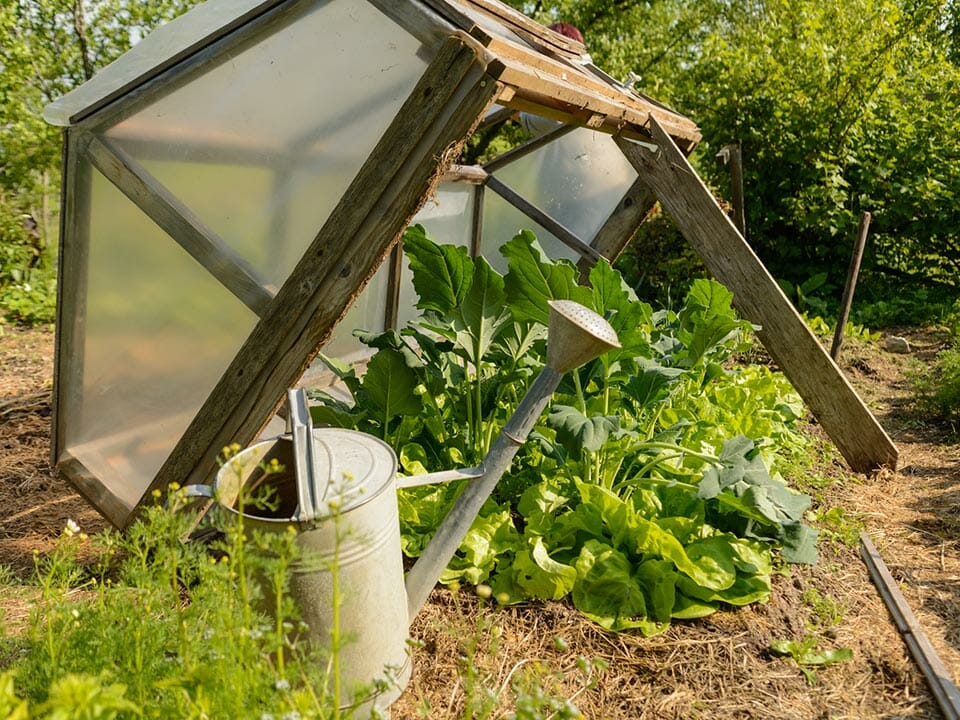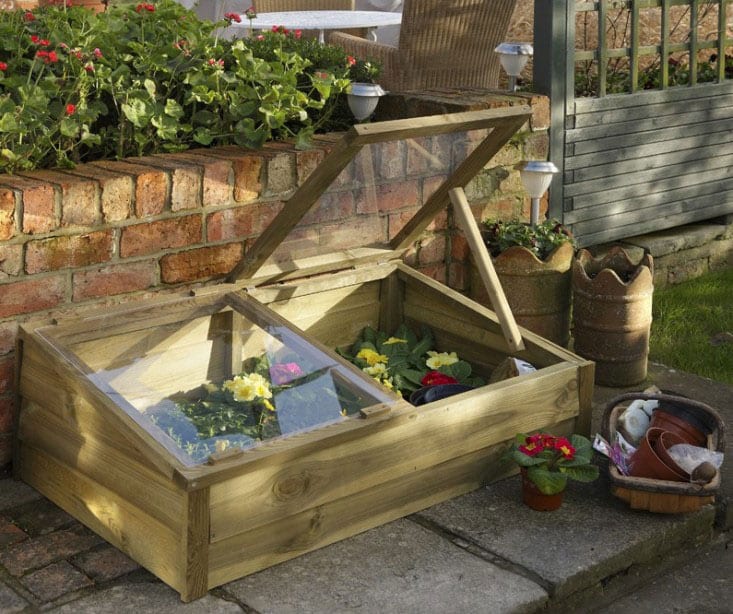A sunny spring morning in my garden. The sun warmed my face, and a soft breeze hinted at the magic of new growth. Wearing my trusty gardening gloves, I was eager to start digging and bring out the hidden life in the soil. But there was a question I couldn’t ignore, something every gardener wonders about: Should I get a greenhouse or a cold frame?
In our exploration of gardening, I’d like you to come along as we look into the classic debate between two options: the greenhouse and the cold frame.
Greenhouses and cold frames are both gardening structures, but they serve different purposes:
Greenhouse:
- Year-round plant growth and climate control.
- Permanent or semi-permanent structures with precise environmental control.
- Suitable for a wide range of plants.
- Larger and more expensive.
Cold Frame:
- Seasonal plant protection from cold and harsh weather.
- Simple structures with passive heating.
- Ideal for cold-hardy plants.
- Smaller and budget-friendly.
What Are the Benefits of Greenhouses for Plants?

Greenhouses offer a plethora of benefits for plants, creating a controlled environment that fosters optimal growth and protection from the elements.
Definition and Basic Description
Greenhouses are enclosed structures primarily made of transparent materials like glass or plastic. They are designed to create a controlled microclimate for plants, allowing for the cultivation of various crops and flowers.
Moreover, greenhouses harness sunlight to maintain a warm and stable environment conducive to plant growth.
Advantages of Greenhouses
Temperature Control
Stable Temperatures: Greenhouses offer precise temperature control, which is crucial for many plants. Heating and cooling systems maintain a consistent temperature, preventing sudden fluctuations that can harm plants.
Year-Round Growing: With temperature control, greenhouses enable year-round cultivation, making it possible to grow plants even in the winter.
Extended Growing Season
Early Planting: Greenhouses allow for early planting in the spring, as they provide protection from late frosts and cold snaps.
Late Harvesting: Similarly, they extend the harvest season into late fall or early winter, maximizing crop yields.
Pest and Disease Protection
Physical Barrier: Greenhouse structures act as a barrier, keeping out many pests and preventing airborne diseases from reaching plants.
Isolation: Isolating plants within a greenhouse minimizes the risk of cross-contamination, reducing the need for chemical pesticides.
Disadvantages of Greenhouses
High Initial Cost
Construction Expenses: Building a greenhouse can be expensive due to the cost of materials, construction labor, and equipment for temperature control.
Maintenance Costs: Ongoing maintenance, such as replacing plastic or glass and servicing heating and cooling systems, can also be costly.
Energy Consumption
Heating and Cooling: Maintaining the desired temperature within a greenhouse often requires energy-intensive systems. Heating during winter and cooling during summer can lead to high energy bills.
Environmental Impact: The energy consumption of greenhouses can have environmental implications, particularly if non-renewable energy sources are used.
Space Requirements
Physical Footprint: Greenhouses occupy a significant amount of space, which may not be feasible for individuals with limited land or garden size.
Zoning Regulations: Depending on the location, local zoning regulations may restrict the construction of large greenhouses, limiting their use.
What Are the Advantages of Cold Frames in Gardening?
Cold frames provide a cost-effective and versatile solution for gardeners, offering numerous advantages in extending the growing season and nurturing plants in various climates.
Definition and Basic Description
Cold frames are simple, low-profile, and unheated garden structures typically made of wood or metal frames with a transparent lid or covering, often made of glass or plastic.
Moreover, they are designed to create a small microclimate similar to a greenhouse but without the active heating and cooling systems.
In addition, cold frames are typically placed close to the ground and can vary in size, making them versatile for different gardening needs.
Advantages of Cold Frames
Lower Cost
Affordability: Cold frames are generally more budget-friendly compared to full-scale greenhouses. They require less expensive materials and no complex heating or cooling systems.
Cost Savings: Moreover, they can extend the growing season without significantly increasing energy bills, making them a cost-effective solution.
Energy Efficiency
Passive Heating: Cold frames rely on passive solar heating, trapping sunlight to raise the temperature inside. This makes them energy-efficient since they don’t require additional energy sources.
Reduced Carbon Footprint: Moreover, cold frames have a smaller environmental impact due to their minimal energy consumption.
Space Flexibility
Adaptability: Cold frames are adaptable and can be easily moved or resized as needed. This flexibility makes them suitable for gardens of varying sizes and layouts.
Protection for Individual Plants: They can be used to protect specific plants or seedlings, offering targeted care.
Disadvantages of Cold Frames
Limited Temperature Control
Reliance on Sunlight: Cold frames rely heavily on available sunlight for temperature regulation. This can result in temperature fluctuations, making them less suitable for certain sensitive plants.
Inadequate for Extreme Cold: In extremely cold climates, cold frames may not provide sufficient protection for plants during harsh winters.
Shorter Growing Season
Seasonal Use: Cold frames extend the growing season but may not allow year-round cultivation in all regions. Moreover, they are most effective in spring and fall when temperatures are milder.
Not Ideal for Tropical Plants: Cold frames are not suitable for tropical or heat-loving plants that require consistently warm conditions.
Less Protection Against Extreme Weather
Vulnerability to Storms: Cold frames may be vulnerable to extreme weather events like heavy snowfall or hail, potentially damaging the structure or plants inside.
Limited Insulation: Unlike greenhouses with better insulation, cold frames offer less protection against temperature extremes.
How Do Greenhouses and Cold Frames Compare for Plant Growth?

When it comes to plant growth, comparing greenhouses and cold frames reveals distinct differences in terms of climate control, versatility, and cost-effectiveness.
Cost Considerations
Initial Investment
Greenhouses: Greenhouses typically require a higher initial investment due to the cost of materials, construction, and specialized systems for temperature control and ventilation. The expense can vary widely based on size and features.
Cold Frames: Cold frames are much more budget-friendly in terms of initial investment. They are simple structures that can be built or purchased at a fraction of the cost of a greenhouse.
Long-Term Expenses
Greenhouses: While greenhouses have higher upfront costs, they often have lower long-term expenses in terms of energy efficiency and maintenance. Efficient heating, cooling, and insulation can lead to cost savings over time.
Cold Frames: Cold frames are generally inexpensive to maintain but may have higher energy costs if additional heating is needed during cold seasons. Their simplicity can also mean they require less maintenance.
Growing Season and Plant Variety
Greenhouses: Greenhouses provide an extended growing season and can support a wide variety of plants, including tropical and exotic species. They are suitable for year-round cultivation in many regions.
Cold Frames: Cold frames extend the growing season but are less effective during extreme cold or hot weather. They are better suited for hardy plants and cool-season crops.
Control Over Temperature and Environment
Greenhouses: Greenhouses offer precise control over temperature and environmental conditions. This level of control is especially beneficial for delicate plants and exotic species. They are well-suited for starting seedlings and growing plants that require specific conditions.
Cold Frames: Cold frames rely on passive temperature regulation through sunlight. While they offer some protection, they have limited control over extreme temperatures and may not be suitable for plants with very specific temperature requirements.
Space Requirements and Flexibility
Greenhouses: Greenhouses generally require more space due to their larger size and the need for additional equipment and systems. They are less flexible in terms of relocation.
Cold Frames: Cold frames are compact and versatile. They can be placed in smaller spaces and are easy to move or resize, providing flexibility for gardeners with limited space or changing needs.
How to Choose the Right Option: Greenhouse or Cold Frame for Your Garden?
Selecting the ideal addition for your garden—whether it’s a greenhouse or a cold frame requires thoughtful consideration of factors such as space, budget, and specific gardening goals.
Budget
Greenhouse: If you have a larger budget and are willing to make a substantial initial investment, a greenhouse may be the right choice. Greenhouses offer greater control and versatility but come with higher upfront costs.
Cold Frame: If you have a limited budget, a cold frame is a more budget-friendly option. They are cost-effective to purchase or build and have lower long-term maintenance expenses.
Space Availability
Greenhouse: Greenhouses require more space due to their larger size and infrastructure. Ensure you have enough open space to accommodate a greenhouse without overcrowding your garden.
Cold Frame: Cold frames are compact and flexible, making them suitable for small gardens or limited space. They can fit in smaller areas and can be easily relocated.
Climate and Local Weather Conditions
Greenhouse: Consider your local climate. Greenhouses are better suited for regions with extreme temperature variations, harsh winters, or hot summers. They provide a stable and controlled environment that can protect plants from adverse weather conditions.
Cold Frame: Cold frames are ideal for milder climates where winter temperatures are not too harsh. They extend the growing season into the colder months but may not provide sufficient protection during severe frosts.
FAQ’s
Can I use a cold frame as a greenhouse?
Yes, a cold frame can function as a simplified greenhouse, but it provides less temperature control and insulation compared to a traditional greenhouse.
What is better than a greenhouse?
A high-tech, controlled environment greenhouse equipped with advanced climate and lighting systems is considered superior for precise and year-round cultivation.
Why is it called a cold frame?
It’s called a “cold frame” because it typically doesn’t have a heating system and relies on passive solar warming, making it suitable for cool-season plants.
Can you grow seeds in a cold frame?
Yes, cold frames are ideal for seed starting as they offer protection from frost and slightly elevated temperatures, fostering seed germination.
Can you grow in a cold frame?
Yes, you can grow a variety of cold-tolerant vegetables and plants in a cold frame during the cooler seasons, extending the growing season.
Do cold frames need ventilation?
Yes, ventilation is essential to prevent overheating on sunny days and to regulate temperature and humidity levels inside the cold frame.
Final Thought
In conclusion, as I’ve explored the options of greenhouses and cold frames and considered the various factors that influence the choice between the two, I’ve found that the decision ultimately depends on my individual gardening goals and circumstances.
Greenhouses offer me precise control over temperature and the ability to extend the growing season, which is great for a variety of plants and areas with extreme climates. However, they do come with higher upfront costs and require more space.
On the other hand, cold frames provide a cost-effective way to extend the growing season in milder climates and fit well in smaller spaces, but they don’t offer the same level of environmental control as greenhouses.
So, for me, the right choice will depend on my specific gardening needs and what works best in my situation. Whether I’m nurturing delicate seedlings or protecting hardy crops, both greenhouses and cold frames offer valuable options to enhance my gardening experience throughout the year.
